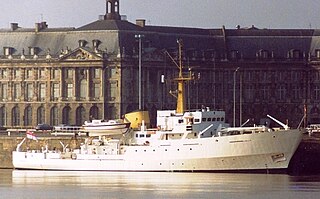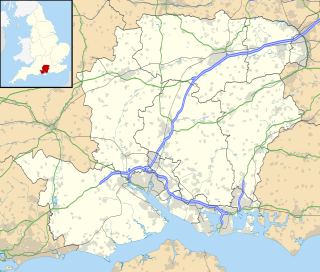
Newport News Shipbuilding (NNS), a division of Huntington Ingalls Industries, is the largest industrial employer in Virginia, and sole designer, builder and refueler of United States Navy aircraft carriers and one of two providers of U.S. Navy submarines. Founded as the Chesapeake Dry Dock and Construction Co. in 1886, Newport News Shipbuilding has built more than 800 ships, including both naval and commercial ships. Located in the city of Newport News, their facilities span more than 550 acres (2.2 km2), strategically positioned in one of the great harbors of the East Coast.

The Kirov-class battlecruiser is a class of nuclear-powered warship of the Russian Navy, the largest and heaviest surface combatant warships in operation in the world. Among modern warships, they are second in size only to large aircraft carriers, and of similar size to a World War 2 era battleship. The official designation of the ship-type is "heavy nuclear-powered guided missile cruiser". The ships are often referred to as battlecruisers by western defense commentators due to their size and general appearance.

The C class was a group of twenty-eight light cruisers of the Royal Navy, and were built in a sequence of seven groups known as the Caroline class, the Calliope class, the Cambrian class, the Centaur class, the Caledon class, the Ceres class and the Carlisle class. They were built for the rough conditions of the North Sea, and proved to be rugged and capable vessels, despite their being somewhat small and cramped.
Seven ships of the Royal Navy have been named HMS Archer, named after a person proficient in archery - an archer:

Suffren was a Suffren-class frigate of the French Navy, designed to protect a fleet against air threats, surface ships, submarines, and, to a lesser extent, provide firepower against land objectives. She is the sister-ship of Duquesne, and was decommissioned in 2001. She was the seventh French vessel named after the 18th century admiral Pierre André de Suffren; her artillery turrets are named after ships commanded by the marquis of Suffren: turret n°1 is named Héros ("hero") after the ship of the line Héros, and turret n°2 is named Fantasque, after the ship of the line Fantasque.

Duquesne is a Suffren-class frigate of the French Navy. The French Navy does not use the term "destroyer" for its ships; hence some large ships, referred to as "frigates", are registered as destroyers. She is designed to protect a fleet against air threats, surface ships, submarines, and, to a lesser extent, provide firepower against land objectives. She is the sister-ship of Suffren. She is the eighth French vessel named after the 17th century admiral Abraham Duquesne. Her weapon systems bear names of battles to which Duquesne took part: Messine, Palerme, Alicuri, Agosta and Stromboli.

USS Maddox (DD-622), a Gleaves-class destroyer, was the second ship of the United States Navy to be named after United States Marine Corps Captain William A. T. Maddox, who served in the Mexican–American War.

Bartolomeo Colleoni was an Italian Giussano-class light cruiser, that served in the Regia Marina during World War II. It was named after Bartolomeo Colleoni, an Italian military leader of the 15th century.
Two ships of the Royal Navy have been named HMS Viking, after the Vikings, whilst another Viking was in service with the Royal New Zealand Navy:

USS Ulysses (ARB-9) was planned as a United States Navy LST-542-class tank landing ship, but was redesignated as one of twelve Aristaeus-class battle damage repair ships built for the United States Navy during World War II. Named for Ulysses, she was the second US Naval vessel to bear the name.
USS Creddock (AM-356) was an Admirable-class minesweeper built for the United States Navy during World War II. The ship was ordered and laid down as PCE-905-class patrol craft USS PCE-916 but was renamed and reclassified before her July 1944 launch as Creddock (AM-356). Creddock was launched 22 July 1944 by Willamette Iron and Steel Works, Portland, Oregon; sponsored by Miss N. I. Schmidleys; and commissioned 18 December 1945, Lieutenant J. C. Elliott, USNR, in command. Creddock departed Astoria, Oregon, 6 January 1946 and arrived at San Diego, California, 4 days later. There she was placed out of commission in reserve 26 March 1946. Creddock was reclassified MSF-356 on 7 February 1955.

USS LST-1074 was an LST-542-class tank landing ship built for the United States Navy during World War II. She was later named Overton County (LST-1074) for the Overton County, Tennessee — the only U.S. Naval vessel to bear the name—but never saw active service under that name.

HMS Beagle was a Bulldog class coastal survey vessel of the Royal Navy and was the ninth to bear the name.

The Ukuru-class escort ships were a class of twenty-nine kaibōkan escort vessels built for the Imperial Japanese Navy during World War II. The class was also referred to by internal Japanese documents as the "Modified B-class" coastal defense vessel, and they were the fourth class of kaibōkan.

HMS Gay Archer was a Gay-class fast patrol boat of the Royal Navy. She was built by Vosper, Portchester, and launched on 20 August 1952.
HM Motor Gun Boat 2007 was a Motor Gun Boat operated by Royal Navy Coastal Forces during the Second World War. She was initially built as one of eight gun boats ordered by the Turkish Navy, but which went on to see service in the North Sea as fast blockade runners. She was initially classed as the merchant vessel Gay Corsair, crewed by men of the merchant navy and sailing under the red ensign. She became HM Motor Gunboat 507 after being acquired by the Royal Navy, and finally HM Motor Gun Boat 2007. She was wrecked under this name in 1945.

The Gay class were a class of twelve fast patrol boats that served with the Royal Navy from the early 1950s. All were named after types of soldiers or military or related figures, prefixed with 'Gay'. The class could be fitted as either motor gun boats or motor torpedo boats, depending on the type of armament they carried.

HMS Gay Bombardier was a Gay-class fast patrol boat of the Royal Navy. She was built by Vosper, Portchester, and launched on 28 August 1952. She was the second ship to be launched in her class.

Kommuna is a submarine salvage ship in service with the Russian Navy's Black Sea Fleet. A double-hulled catamaran, she was laid down at the Putilov Factory in St. Petersburg in November 1912 as Volkhov. The ship was launched the following year, and commissioned on 14 July 1915. She was renamed Kommuna on 31 December 1922. Kommuna has served in the Russian Imperial, Soviet, and Russian Federation navies through the Russian Revolution and two World Wars.
















